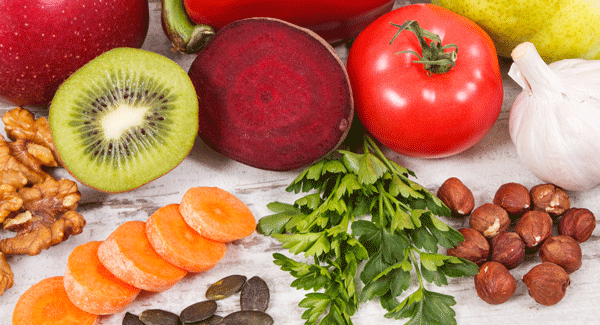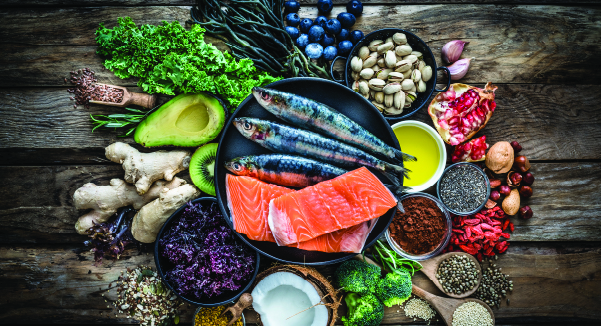Eat Right for Your Type of Arthritis
Learn about diets that may help ease pain and inflammation and slow disease activity.
By Michele Andwele | June 18, 2021
When you have arthritis or a related condition, getting the right nutrients may help alleviate pain and inflammation and improve your overall health.
Although there is no magic potion at the supermarket, studies have shown that certain foods have anti-inflammatory properties and specific benefits for autoimmune, inflammatory forms of arthritis, like rheumatoid arthritis (RA) and psoriatic arthritis (PsA), as well as gout, osteoarthritis (OA) and osteoporosis. An anti-inflammatory diet may slow disease activity and reduce symptoms.
Different types of arthritis respond differently to food. This article breaks down why omega-3-rich foods may help some people, while limiting purines matters more for others. Your support helps keep practical, tailored nutrition guidance available.
Give today.
Autoimmune, Inflammatory Arthritis
Rheumatoid arthritis has been the focus of most studies about nutrition and autoimmune, inflammatory forms of arthritis. Many have found a diet rich in omega-3 fatty acids, antioxidants and phytochemicals that supply the body with anti-inflammatory nutrients helps ease RA symptoms.
In a Mediterranean-style diet, these nutrients are found in fruits and vegetables, fish, olive oil, unrefined grains, nuts, seeds and beans. In addition, the Mediterranean diet includes moderate poultry, dairy and eggs, and it minimizes meats, especially red meats, highly processed and refined foods, and unhealthy fats, including saturated fats. Studies examining the diet’s impact on RA have shown improvements in pain, morning stiffness, physical function as well as reduced markers of inflammation in the blood, according to a meta-analysis published in 2020 in Nutrition Reviews. Omega-3 fatty acids in salmon, sardines, mackerel, herring, tuna and other cold-water fish have been shown to be particularly beneficial for their anti-inflammatory properties.
Studies also have shown that extra virgin olive oil is beneficial for rheumatoid arthritis. Investigators found that oleocanthal, a compound in olive oil, helped control chronic inflammation and inflammatory processes and helped reduce joint cartilage damage. Earlier studies found that, similar to ibuprofen, oleocanthal prevents the production of pro-inflammatory COX-1 and COX-2 enzymes.
To learn about the effects of specific foods on inflammatory arthritis, researchers surveyed RA patients about 20 different foods. Among them, blueberries, fish, strawberries and spinach were most often reported to help RA symptoms, while desserts and sugar-sweetened sodas were most often reported to worsen symptoms, according to a report published in 2017 in Arthritis Care and Research.
Green tea also may be beneficial to some people with inflammatory arthritis. According to a study published in 2016 in Arthritis & Rheumatology, an anti-inflammatory phytochemical in green tea known as EGCG (epigallocatechin-3-gallate) blocks the effects of RA.
Several studies have looked at the effects of vegetarian and vegan diets on RA going back to the 1990s, before biologic medications were widely used. And while it’s long been known that limiting food consumption inhibits inflammation, researchers also have found that a period of fasting followed by a vegetarian diet may also benefit inflammatory arthritis patients, although it’s important to note that the patients continued their medication during the trials. According to the 2020 meta-analysis in Nutrition Reviews, studies show that restricting calories for seven to 10 days followed by a vegetarian diet for a year or more resulted in less pain, morning stiffness and inflammatory biomarkers. A study published in 2019 in Nutrients linked intermittent fasting with reduced disease activity in psoriatic arthritis.
Some studies also have found that a diet high in fiber helps reduce levels of C-reactive protein (CRP) in the blood, a marker of inflammation associated with RA and other inflammatory forms of arthritis. Good sources of dietary fiber include whole grains and legumes, including oatmeal, brown rice, beans and barley.
Osteoarthritis
Having a balanced, nutritious diet is important for reaching and maintaining a healthy weight, which is critical for joint health. Every pound of extra weight adds four pounds of pressure on weight-bearing joints, including knees, hips and ankles. This not only can worsen joint damage and pain, but fat cells also contribute to inflammation in the body. Incorporating physical activity with diet to reduce weight has been shown to be most effective for weight loss and can ease OA symptoms, too.
Researchers have looked at numerous different foods and nutrients for their potential impact on OA progression and symptoms. Some studies have found that deficiencies of vitamins D and K are associated with more bone and cartilage damage and worse OA. Vitamin D, which comes from sun exposure, is hard to get from food. The few food sources include fatty fish, mushrooms and fortified foods, including milk and some orange juices and cereals. Leafy greens are good sources of vitamin K.
At least one other study found that those who ate more dietary fiber were less likely to have knee OA symptoms.
Dietary fats also appear to have an effect on OA progression. A study of the NIH Osteoarthritis Initiative, published in 2017 in Arthritis Care & Research, found that saturated fats, such as those in red meats, are associated with the progression of knee OA, while monounsaturated fats, like fish oil, and polyunsaturated fats, such as extra virgin olive oil, appear to have a protective effect against OA.
Fruits, in particular blueberries, raspberries, strawberries and pomegranates, which are rich in polyphenols like anthocyanins and quercetin, have antioxidant and anti-inflammatory properties that may help prevent and manage OA, according to a 2018 study in Food & Function.
Broccoli and other cruciferous vegetables contain a compound called sulforaphane that research shows also may inhibit inflammation and slow OA progression. And some studies have found that consuming milk (but not cheese) or eating garlic, onions and leeks may be linked to less OA progression and symptoms.
However, the results of research on specific foods or nutrients are often mixed, and people don’t eat based on single foods or nutrients; they eat diets containing a variety of foods, so some researchers have taken a broader approach.
For a 2020 study published in Arthritis Research and Therapy, study participants’ diets were assessed based on an inflammatory index. Researchers found that diets with higher inflammatory scores had a greater association with knee OA. That’s partly because those diets also tended to be associated with weight gain, and therefore involved a higher body mass index and more pressure on knees.
And in a study looking at a Mediterranean-style diet published in 2017 in The Journal of Nutrition, Health and Aging, participants who ate the diet for 16 weeks had decreased levels of an inflammatory protein in their blood and significant improvements in hip and knee range of motion compared to those who weren’t on the diet.
The upshot: a diet that incorporates more anti-inflammatory foods and fewer inflammatory foods, such as a Mediterranean or DASH diet, is less likely to worsen OA — and may be protective against it — than a diet high in meats, sugars and processed foods,
Gout
Of all the forms of arthritis, gout might have the most obvious dietary link. When the body breaks down purine, a substance found in many foods, uric acid forms. People who have gout, an inflammatory form of arthritis, have trouble eliminating uric acid or they produce too much uric acid. The uric acid builds up and forms crystals that lodge in joints, causing severe pain in joints.
Avoiding foods that contain high levels of purines is a critical part of managing gout. These foods include meats (particularly red meats such as beef, pork and lamb and organ meats), most seafood (both fish and shellfish) and meat-based broths and gravies. Sugar-sweetened soft drinks and food with fructose also increase uric acid levels. There is a strong association between alcohol intake, especially beer, and an increased risk of gout attacks.
Several studies have found that adherence to a Mediterranean diet lowered levels of uric acid in the blood and therefore the risk of developing gout or gout attacks.
More recently, a study published in December 2020 Arthritis & Rheumatology linked the DASH diet with lower uric acid levels in the blood, particularly in people with excessively high levels. Researchers assigned more than 450 people to different diets for eight weeks: a typical American diet (the control group), a typical American diet but with more fruits and vegetables, or the DASH diet with plenty of fruits and vegetables, low-fat dairy and low in fat, saturated fat and cholesterol. Compared with the typical American diet, the DASH diet significantly lowered uric acid, especially in those with elevated levels.
Another study, published in June 2021 in American Journal of Clinical Nutrition, suggests a DASH-style diet emphasizing plant-based protein lowers uric acid more than similar diets that emphasize either low carbohydrates or unsaturated fats.
Some studies have focused on specific foods. For example, research suggests that components in both sweet and tart cherries give them antioxidant and anti-inflammatory properties that help reduce gout flare frequency as well as joint and bone damage, according to a 2019 study in Therapeutic Advances in Musculoskeletal Disease. These components include anthocyanins, found in red, blue and purple fruits and vegetables, and the flavonol quercetin. Several studies also suggest that vitamin C may lower uric acid and have a protective effect against gout — another reason to bulk up on fruits and vegetables like citrus, bell peppers, broccoli and Brussels sprouts.
Using data from the 14,809 participants in the Third National Health and Nutrition Examination Survey, researchers from Harvard Medical School confirmed that coffee — but not tea — consumption is associated with lower uric acid levels. Several studies also have linked the consumption of dairy products, including milk and yogurt, to lower uric acid levels.
Osteoporosis
The body of research into nutrition and osteoporosis suggests you can protect bone health and lower your risk of fractures by eating foods rich in calcium, including milk, yogurt and other dairy products as well as leafy greens, shellfish, some soy products, and seeds and nuts including almonds, chia and sunflower seeds. Also key to bone strength is vitamin D, which comes from sun exposure and from food sources including salmon, tuna, mackerel, egg yolks, some mushrooms and fortified foods such as milk.
Calcium and vitamin D are historically the two nutrients considered essential for bone health, but other nutrients and diets have received attention in recent years.
According to nutrition recommendations published in 2017 in EFORT Open Reviews, eating more fruits and vegetables is necessary for good bone health. These contain phytochemicals and micronutrients needed for bone rebuilding and resorption and reducing inflammation and oxidative stress. Dried fruits — prunes in particular — are rich sources of bone-strengthening vitamins and minerals, including vitamin K, boron, copper and potassium.
A report from the Framingham Osteoporosis Study, published in 2015 in Current Osteoporosis Reports, that vitamins A, B, C and E are among other nutrients helpful for bone health.
A diet rich in fruits, vegetables and seafood is also linked with greater bone mineral density and lower fracture risk, while a diet high in fat and processed food has been found to be detrimental to bone health. An analysis of studies published in 2021 in Nutrients supports eating a Mediterranean-style diet that’s rich in fruits, vegetables, whole grains and seafood and moderate alcohol (red wine) — but drinking more than in moderation is harmful to bones.
When nutrition guidance is clear and relatable, it can inspire real change.
Your support helps ensure this kind of content remains accessible to anyone who needs it.




